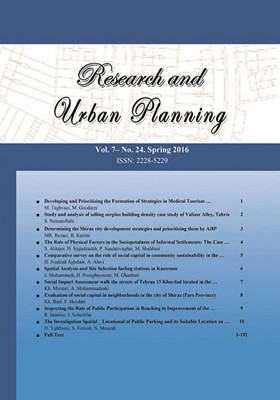Evaluating the performance of transportation networks in case of disaster in suburban areas (Case Study: suburban areas at north of the city of Tabriz)
Subject Areas :A. Asghari 1 , F. Babaei 2 , M. Miralanogh 3
1 - دانشگاه تبریز
2 - دانشگاه تبریز
3 - دانشگاه زنجان
Keywords: Model, Tabriz, Suburban areas, road networks, Inversion Hierarchical Weight Process,
Abstract :
transportation networks is one of the main factors in crisis management there. In case of inefficient transportation networks during unexpected events, they will cause major problems in providing assistance rather than addressing the problems and facilitating the transportation. There exists a direct relationship between the time to reach to the place of the event and the loss of life. This actually requires efficient transportation networks. The other discussion is that in cities, especially cities in less developed countries, all over the city are not equally vulnerable to disasters. Compared to other parts of the city, due to their specific characteristics, suburban areas are more vulnerable to disasters. Human populations living in these areas due to the large volume of strong and irrefutable scientific and practical importance and necessity of study and action in relation to these areas. The main objective of this research is to find out the coefficient of performance of transportation networks in suburban areas at north part of Tabriz (study area of this research) at the time of crisis. The research method in the study is descriptive, analytic and field study. To achieve the research objectives of the Inversion Hierarchical Weight Process model is used. Thirteen indicator in this model that could be effective in network vulnerabilities was selected road networks and Were analyzed. Final results showed that out of the 16 networks in suburban areas of north part of the city of Tabriz, two transportation roads are not vulnerable
اسدی نظری، م (1383)، برنامهریزی و مکانیابی اردوگاههای اسکان موقت بازماندگان زلزله(نمونه موردی: منطقه 1 شهرداری تهران)، پایاننامه کارشناسی ارشد، گروه شهرسازی(برنامهریزی شهری و منطقهای)، دانشکده هنر، دانشگاه تربیت مدرس.
پورکرمانی، م (1377)، لرزه خیزی ایران”، انتشارات دانشگاه شهید بهشتی.
ترابی، کمال (1388)، بررسی نقش شبکه های ارتباطی در کاهش اثرات ناشی از زلزله- مورد مطالعه: منطقه 6 شهرداری تهران با تاکید بر ناحیه 1، پایان نامه کارشناسی ارشد، دانشکده معماری و شهرسازی، دانشگاه علم و صنعت ایران.
تقوایی، م. عزیزی، د. (1387)، برنامهریزی و مدیریت بحران شهری با تأکید بر امکانات، تأسیسات، خدمات و مکانگزینی مراکز درمانی و بهداشتی-درمانی، انتشارات کنکاش.
شیعه، ا، حبیبی، ک، ترابی، ک (1389)، مقاله بررسی آسیب پذیری شبکههای ارتباطی شهرها در مقابل زلزله با استفاده از IHWP و GIS، باغ نظر، شماره سیزده، سال هفتم، صفحه 35-48.
صرافی ، م (1381)، مساله ای به نام اسکان غیررسمی . فصلنامه هفت شهر.
عابدین درکوش، س (1383)، درآمدی بر اقتصاد شهری، مرکز نشر دانشگاهی، تهران.
عبدالهی، م (1380)، مدیریت بحران در نواحی شهری، انتشارات انوار، تهران.
محمدقلی نیا، ج (1385)، آشنایی با مدیریت بحران، تهران، نشر ارسباران.
مرکز مطالعات مقابله با سوانح طبیعی ایران(1375)، برنامه ریزی کاربری زمین در مناطق زلزله خیز(نمونه شهرهای لوشان، منجیل، رودبار)، مرکز مقابله با بلایای طبیعی ایران، تهران.
مطالعات شهرسازی (1388)، طرح ریز پهنه بندی خطر زمین لرزهای شهر تبریز، جلد اول.
میرآلانق، م (1394)، ارزیابی سطح کارایی شبکه های ارتباطی به هنگام بروز حوادث غیرمترقبه در مناطق حاشیه نشین، پایان نامه کارشناسی ارشد، دانشگاه زنجان.
Cova, T. and Johnson, J (2003), A Network Flow Model for Lane-Based Evacuation Routing, Transportation Research Part A, 37: 579-604.
Erdik, M (2008), Earthquake Vulnerability of Buildings and a Mitigation Strategy: Case of Istanbul, The 14 th World Conference on Earthquake Engineering October 12-17.
Husdal, J, (2006), Transport Network Vulnerability: Which Terminology and Metrics Should We Use? Paper presented at the NECTAR Cluster 1 Seminar, Norway: 1-9.
Kreimer, A. Arnold ,A and Carlin ,A (2003), “ Building safer cities, The future of disaster risk”, World bank. Disaster risk management series, Vol. 3.
Lewis, T. G (2006), critical infrasturcture protection in homeland security: defending a networked nation, published by john wiley & sons, Inc.
Miriam, H – Shulman, L (2008), Estimating Evaluation Vulnerability Of Urban Transportation Systems Using GIS, A thesis submitted to the Department of Geography In conformity with the requirements for the degree of Master of Arts, Queen’s University Kingston, Ontario, Canada.
Shen, W.; Nie, Y and Zhang, H (2007), A Dynamic Network Simplex Method for Designing Emergency Evacuation Plans, Transportation Research Board, TRB 2007 Annual Meeting, Paper: 07-2419: 1-25.
Sohn, J (2006), Evaluating the Significance of Highway Network Links under the Flood Damage: An Accessibility Approach, Transportation Research Part A, 40: 491-506.
Taylor, M.; Sekhar, S. and D’Este, G (2006), Application of Accessibility Based Methods for Vulnerability Analysis of Strategic Road Networks, Network Spatial Economy, 6: 267-291.


